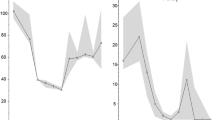Summary
The effect of dopamine during barbiturate therapy was investigated in 29 cats including 5 sham-operated cats. According to Kiersey's classification of electro-encephalographic patterns, physiological variables, cerebral metabolic rates for oxygen and glucose, cerebral blood flow (CBF), and intracranial pressure (ICP), etc. were evaluated in each electro-encephalographic pattern. Oxygen-glucose index was calculated and used as an indicator for aerobic or anaerobic metabolism of glucose.
Group 1 (12 cats), to which only thiamylal was administered, maintained aerobic glycolysis due to a parallel reduction of cerebral metabolic rates for oxygen and glucose (about half of the initial value at Kiersey's fifth pattern) in spite of reduction of CBF and mean arterial blood pressure (MABP).
Group 2 (12 cats), to which dopamine was administered in addition to thiamylal due to a reduction of MABP, showed anaerobic glycolysis though MABP and CBF were maintained.
These findings are ascribed to an increase of cerebral metabolic rate for glucose up to 130% of the initial value though cerebral metabolic rate for oxygen decreased down to half of the initial value: The beneficial effect of barbiturate on cerebral metabolism was reduced by use of dopamine. ICP was reduced in both groups. Our result indicates that administration of extracellular fluid may be preferable for treatment of hypotension during barbiturate therapy than dopamine medication.
Similar content being viewed by others
References
Astrup J, Symon L (1981) Thresholds in cerebral ischemia. The ischemic penumbra. Stroke 12: 723–725
Brawley BW (1968) The pathophysiology of intracerebral steal following carbon dioxide inhalation, an experimental study. Scand J Clin Lab Invest 22 [Suppl 102]: 13B
Brown FD, Hanlon K, Nullan S (1978) Treatment of aneurysmal hemiplegia with dopamine and mannitol. J Neurosurg 49: 525–529
Carter JP, Erspamer R, White WL, Yamagata S (1982) Cortical blood flow during craniotomy for aneurysm. Surg Neurol 17: 204–208
Cusick JF, Myklebust J (1980) Continuous quantative local cerebral blood flow measurement. Calibration of thermal conductivity measurements by the hydrogen clearance method. Stroke 11: 661–664
Edvinsson L, Hardebo JE, Harper AM, McCulloch J, Owman Ch (1977) Action of dopamine agonists on brain vessels in vitro and after in vivo microapplication. Acta Neurol Scand 64 [Suppl 56]: 350–351
Edvinsson L, Hardebo JE, McCulloch J, Owman Ch (1978) Effects of dopaminergic agonists and antagonists on isolated cerebral blood vessels. Acta Physiol Scand 104: 349–359
Goldberg LI (1972) Cardiovascular and renal actions of dopamine: Potential clinical applications. Pharmacol Rev 24: 1–29
Harvey SC (1985) Barbiturates. In: Gilman AG, Goodman LS, Rall TW, Murad F (eds) The pharmacological basis of therapeutics, 7th ed. Macmillan Publishing Co., Inc, New York, pp 351–360
Heiss WD, Rosner G (1983) Functional recovery of cortical neurons as related to degree and duration of ischemia. Ann Neurol 14: 294–301
Kebabian JW, Calne DB (1979) Multiple receptors for dopamine. Nature 277: 93–96
Kiersey DK, Bickford RG, Faulconer A Jr (1951) Electro-encephalographic patterns produced by thiopental sodium during surgical operations: description and classification. Br J Anaesth 23: 141–152
Kosnik EJ, Hunt WE (1976) Postoperative hypertension in the management of patients with intracranial arterial aneurysms. J Neurosurg 45: 148–154
McCulloch J, Harper AM (1977) Cerebral circulation: effect of stimulation and blockade of dopamine receptors. Am J Physiol 233: H222-H227
McCulloch J, Teasdale G (1979) Effects of apomorphine upon local cerebral blood flow. Eur J Pharmacol 55: 99–102
Michenfelder J (1974) The interdependency of cerebral functional and metabolic effects following massive doses of thiopental in the dog. Anesthesiology 41: 231–236
Nakagawa Y, Kinomoto H, Abe H (1986) Effects of dopamine on cortical blood flow and somatosensory evoked potentials in the acute stages of cerebral ischemia. Stroke 17: 25–30
Niimi T, Sawada T, Kuriyama Y, Naritomi H, Kamido H (1981) The effect of dopamine on cerebral circulation and metabolism in man. Jpn J Stroke 3: 318–325
Nordström CH, Messeter K, Sundbärg G, Schalen W, Werner M, Ryding E (1988) Cerebral blood flow, vasoactivity, and oxygen consumption during barbiturate therapy in severe traumatic lesions. J Neurosurg 68: 424–431
Oldendorf WH (1971) Brain uptake of radiolabelled amino acids, amines, and hexoses after arterial injection. Am J Physiol 221: 1629–1639
Safar P, Bleyaert A, Nemoto EM, Moossy J, Snyder JV (1978) Resuscitation after global brain ischemia-anoxia. Crit Care Med 6: 215–227
Samson DS, Beyer CM (1980) Thiopental coma in the treatment of vasospasm-induced cerebral ischemia/infarction. In: Wilkins RH (ed) Cerebral arterial spasm (Proceedings of the second international workshop). Williams and Wilkins, Baltimore, pp 634–636
Sato M, Tanaka S, Suzuki K, Kohama A, Fujii C (1989) Complication associated with barbiturate therapy. Resuscitation 17: 233–241
Sharkey J, McCulloch J (1985) Relationship between local cerebral blood flow and glucose utilization with selective dopamine receptor agonists. J Cereb Blood Flow Metab 5 [Suppl 1]: 537–538
Sharkey J, McCulloch J (1986) Dopaminergic mechanism in the regulations of cerebral blood flow and metabolism: role of different receptor subtypes. In: Owman C, Hardebo JE (eds) Neural regulation of brain circulation. Elsevier Science Publishers B.V., pp 111–127
Tanaka K, Greenberg JH, Gonatas NK, Reivich M (1985) Regional flow-metabolism couple following middle cerebral artery occlusion in cats. J Cereb Blood Flow Metab 5: 241–252
Tuor UI, Edvinsson L, McCulloch J (1986) Catecholamines and the relationship between cerebral blood flow and glucose use. Am J Physiol 251: H824–833
von Essen C (1974) Effects of dopamine on the cerebral blood flow in the dog. Acta Neurol Scand 50: 39–52
von Essen C, Zervas NT, Brown DR, Koltun WA, Pickren KS (1980) Local cerebral blood flow in the dogs during intravenous infusion of dopamine. Surg Neurol 13: 181–188
Ward JD, Becker DP, Miller JD, Choi SC, Marmarou A, Wood C, Newlon PG, Keenan R (1985) Failure of prophylactic barbiturate coma in the treatment of severe head injury. J Neurosurg 62: 383–388
Author information
Authors and Affiliations
Rights and permissions
About this article
Cite this article
Sato, M., Niiyama, K., Kuroda, R. et al. Influence of dopamine on cerebral blood flow, and metabolism for oxygen and glucose under barbiturate administration in cats. Acta neurochir 110, 174–180 (1991). https://doi.org/10.1007/BF01400687
Issue Date:
DOI: https://doi.org/10.1007/BF01400687




